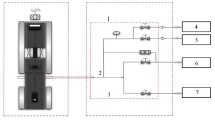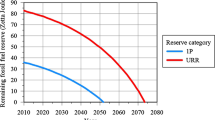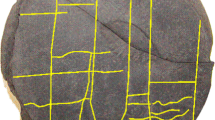Abstract
An analytical solution is developed for the shale gas productivity of a multiple-fractured horizontal well based on a diffusion model and a trilinear flow pattern. The shale gas reservoir is divided into three flow regions: hydraulic-fracture region, micro-fracture network or dual-porosity region, and pure-matrix region. For the pure-matrix region, a transient diffusion equation is solved based on our previous diffusivity model developed for the shale matrix. For the micro-fracture network region, a modified dual-porosity model is proposed wherein both the free and adsorbed gases in the shale matrix flow into the micro-fracture network through a pseudo-steady diffusion process. These gases then form conflux at the hydraulic fractures and continue to the wellbore. A dimensionless solution is obtained for the bottom-hole pressure in the Laplace domain considering the skin effect. An analytical solution is obtained for the gas production rate in a real-time domain through a partial Taylor series simplification and Laplace inverse transform. This analytical solution is compared with the field data of the shale gas produced from a fractured horizontal well located in southwestern China, and a good agreement is observed. Finally, a parametric study is conducted to quantify the effects of key parameters on the gas production rate. The parameters include the bottom-hole pressure, half-length of the hydraulic fracture, permeability of the hydraulic fracture, block size of the shale matrix, and pore size within the shale matrix. These results show that the analytical solution can be used to estimate the enhancement of the shale gas recovery through hydraulic fracturing.
Similar content being viewed by others
Abbreviations
- a :
-
Shape factor, \(\hbox {m}^{-2}\), \(a={3\pi ^{2}}/{L^{2}}\)
- \(d_\mathrm{m}\) :
-
Molecular collision diameter, m
- \(d_\mathrm{p}\) :
-
Size of pores with shale matrix, m
- \(D_\mathrm{m}\) :
-
Gas apparent diffusivity in shale matrix, \(\hbox {m}^{2}/\hbox {s}\)
- \(D_\mathrm{f}\) :
-
Pseudo-gas diffusivity of micro-fractures network, \(\hbox {m}^{2}/\hbox {s}\)
- \(D_\mathrm{F}\) :
-
Pseudo-gas diffusivity of hydraulic fractures, \(\hbox {m}^{2}/\hbox {s}\)
- \(D_\mathrm{K}\) :
-
Knudsen diffusion coefficient, \(\hbox {m}^{2}/\hbox {s}\)
- \(D_\mathrm{S}\) :
-
Surface diffusion coefficient, \(\hbox {m}^{2}/\hbox {s}\)
- \(D_{\mathrm{f}'}\) :
-
Fractal dimension of the pores surface, dimensionless
- h :
-
Reservoir thickness, m
- \(k_\mathrm{f}\) :
-
Permeability of micro-fractures network, m\(^{2}\)
- \(k_\mathrm{F}\) :
-
Permeability of hydraulic fractures, m\(^{2}\)
- Kn :
-
Knudsen number, \(Kn=\frac{\kappa _{B}T}{\sqrt{2}\pi d_\mathrm{m}^{2} d_\mathrm{p} p_\mathrm{m}}\)
- L :
-
The size of shale matrix block, m
- \(M_\mathrm{g}\) :
-
Apparent molecular weight of shale gas, kg/mol
- N :
-
Number of hydraulic fractures
- \(p_\mathrm{i}\) :
-
Initial reservoir pressure, \(P_\mathrm{a}\)
- \(P_\mathrm{L}\) :
-
Langmuir pressure constant, \(P_\mathrm{a}\)
- \(p_{{\mathrm{sc}}}\) :
-
Gas pressure at standard condition, \(P_\mathrm{a}\)
- \(p_\mathrm{w}\) :
-
Bottom-hole pressure, \(P_\mathrm{a}\)
- \(q_{{\mathrm{Fsc}}}\) :
-
Hydraulic-fracture production rate at standard condition, \(\hbox {m}^{3}/\hbox {s}\)
- \(r_\mathrm{w}\) :
-
Wellbore radius, m
- s :
-
Variable of Laplace transformation, dimensionless
- \(s_\mathrm{c}\) :
-
Horizontal well flow choking skin factor, dimensionless
- t :
-
Production time, s
- T :
-
Reservoir temperature, K
- V :
-
Volumetric gas concentration, sm\(^{3}\)/m\(^{3}\)
- \(V_\mathrm{i}\) :
-
Volumetric gas concentration at initial condition, sm\(^{3}\)/m\(^{3}\)
- \(V_\mathrm{E}\) :
-
Equilibrium volumetric gas concentration, \({\hbox {m}^{3}}/{\hbox {m}^{3}}\)
- \(V_\mathrm{L}\) :
-
Langmuir volume (at standard condition), m\(^{3}/\hbox {m}^{3}\)
- \(w_\mathrm{F}\) :
-
Hydraulic-fracture width, m
- \(x_\mathrm{e}\) :
-
Fractured reservoir volume half-width, m
- \(x_\mathrm{F}\) :
-
Hydraulic-fracture half-length, m
- \(y_\mathrm{e}\) :
-
Half-distance between hydraulic fractures, m
- Z :
-
Z factor of shale gas, dimensionless
- \(\phi \) :
-
Porosity for shale matrix 1, 2, micro-fractures system and hydraulic fracture, fraction
- \(\sigma \) :
-
Adsorption index, dimensionless
- \(\varepsilon \) :
-
Free index, dimensionless
- \({\delta }'\) :
-
The ratio of normalized molecular size to local average pore diameter \({\delta }'=d_\mathrm{m}/d_\mathrm{p}\)
- \(\kappa _\mathrm{B}\) :
-
Boltzmann constant, \(1.381\times 10^{-23}\hbox {J/K}\)
- \(\omega _{K}\) :
-
The probability function of collisions with wall, \(\omega _K =\frac{Kn}{Kn+1}\)
- \(\tau \) :
-
Gas diffusion time in shale matrix, s
- \(\tau _h\) :
-
Tortuosity of pores of shale matrix, dimensionless
- \(\rho _\mathrm{g}\) :
-
Shale gas density, kg/m\(^{3}\)
- \(\rho _{{\mathrm{gsc}}}\) :
-
Shale gas density at standard condition, kg/m\(^{3}\)
- \(\mu \) :
-
Gas viscosity, \(\hbox {Pa}\cdot \hbox {s}\)
- \(\psi \) :
-
Pseudo-pressure, \(\hbox {P}_\mathrm{a}/\hbox {s}\)
- \(\psi _\mathrm{L}\) :
-
Pseudo-Langmuir pressure constant, \(\hbox {P}_\mathrm{a}/\hbox {s}\)
- D :
-
Dimensionless
- i :
-
Initial condition
- w :
-
Wellbore
- m :
-
Matrix
- f :
-
Micro-fractures
- F :
-
Hydraulic fractures
- sc :
-
Standard condition
- L:
-
Langmuir’s constant
- −:
-
Laplace transform
References
Kang, Y.; Chen, M.; Li, X.; You, L.; Yang, B.: Laboratory measurement and interpretation of nonlinear gas flow in shale. Int. J. Mod. Phys. C 26(06), 1550063 (2015)
Zhang, J.; Huang, S.; Cheng, L.; Xu, W.; Liu, H.; Yang, Y.; Xue, Y.: Effect of flow mechanism with multi-nonlinearity on production of shale gas. J. Nat. Gas Sci. Eng. 24, 291–301 (2015)
Xu, J.; Guo, C.; Wei, M.; Jiang, R.: Production performance analysis for composite shale gas reservoir considering multiple transport mechanisms. J. Nat. Gas Sci. Eng. 26, 382–395 (2015)
Liu, J.; Wang, J.G.; Gao, F.; Ju, Y.; Zhang, X.; Zhang, L.: Flow consistency between non-Darcy flow in fracture network and nonlinear diffusion in matrix to gas production rate in fractured shale gas reservoirs. Transp. Porous Media 111, 97–121 (2016)
Sang, Y.; Chen, H.; Yang, S.; Guo, X.; Zhou, C.; Fang, B.; Zhou, F.; Yang, J.: A new mathematical model considering adsorption and desorption process for productivity prediction of volume fractured horizontal wells in shale gas reservoirs. J. Nat. Gas Sci. Eng. 19, 228–236 (2014)
Chen, L.; Kang, Q.; Pawar, R.; He, Y.; Tao, W.: Pore-scale prediction of transport properties in reconstructed nanostructures of organic matter in shales. Fuel 158, 650–658 (2015)
Wang, W.; Shahvali, M.; Su, Y.: A semi-analytical fractal model for production from tight oil reservoirs with hydraulically fractured horizontal wells. Fuel 158, 612–618 (2015)
Zhao, Y.; Zhang, L.; Liu, Y.; Hu, S.; Liu, Q.: Transient pressure analysis of fractured well in bi-zonal gas reservoirs. J. Hydrol. 524, 89–99 (2015)
Lin, R.; Ren, L.; Zhao, J.; Wu, L.; Li, Y.: Cluster spacing optimization of multi-stage fracturing in horizontal shale gas wells based on stimulated reservoir volume evaluation. Arab. J. Geosci. 10(2), 38 (2017)
Yang, S.Q.; Ranjith, P.G.; Jing, H.W.; Tian, W.L.; Ju, Y.: An experimental investigation on thermal damage and failure mechanical behavior of granite after exposure to different high temperature treatments. Geothermics 65, 180–197 (2017)
Wang, H.: Performance of multiple fractured horizontal wells in shale gas reservoirs with consideration of multiple mechanisms. J. Hydrol. 510, 299–312 (2014)
Zhang, J.; Huang, S.; Cheng, L.; Ai, S.; Teng, B.; Guan, Y.; Xue, Y.: A mathematical model for drainage and desorption area analysis during shale gas production. J. Nat. Gas Sci. Eng. 21, 1032–1042 (2014)
Alom, MdS; Tamim, M.; Rahman, M.M.: Decline curve analysis using rate normalized pseudo-cumulative function in a boundary dominated gas reservoir. J. Petrol. Sci. Eng. 150, 30–42 (2017)
Guo, C.; Xu, J.; Wei, M.; Jiang, R.: Pressure transient and rate decline analysis for hydraulic fractured vertical wells with finite conductivity in shale gas reservoirs. J. Petrol. Explor. Prod. Technol. 2014, 1–9 (2014)
Jiang, R.; Xu, J.; Sun, Z.; Guo, C.; Zhao, Y.: Rate transient analysis for multistage fractured horizontal well in tight oil reservoirs considering stimulated reservoir volume. In: Mathematical Problems in Engineering. Article ID489015, p. 11 (2014)
Tian, L.; Xiao, C.; Liu, M.; Gu, D.; Song, G.; Cao, H.; Li, X.: Well testing model for multi-fractured horizontal well for shale gas reservoirs with consideration of dual diffusion in matrix. J. Nat. Gas Sci. Eng. 21, 283–295 (2014)
Guo, J.; Zhang, L.; Zhu, Q.: A quadruple-porosity model for transient production analysis of multiple-fractured horizontal wells in shale gas reservoirs. Environ. Earth Sci. 73(10), 5917–5931 (2015)
Huang, T.; Guo, X.; Chen, F.: Modeling transient flow behavior of a multiscale triple porosity model for shale gas reservoirs. J. Nat. Gas Sci. Eng. 23, 33–46 (2015)
Zhao, Y.; Zhang, L.; Luo, J.; Zang, B.: Performance of fractured horizontal well with stimulated reservoir volume in unconventional gas reservoir. J. Hydrol. 512, 447–456 (2014)
Chen, Z.; Liao, X.; Zhao, X.; Lyu, S.; Zhu, L.: A comprehensive productivity equation for multiple fractured vertical wells with non-linear effects under steady-state flow. J. Petrol. Sci. Eng. 149, 9–24 (2017)
Liu, J.; Wang, J.G.; Gao, F.; Ju, Y.; Tang, F.: Impact of micro- and macro- consistent flows on well performance in fractured shale gas reservoirs. J. Nat. Gas Sci. Eng. 36, 1239–1252 (2016)
Xiong, X.; Devegowda, D.; Michel, G.; Sigal, R.; Civan, F.: A fully-coupled free and adsorptive phase transport model for shale gas reservoirs including non-Darcy flow effects. In: SPE 159758, Presented at the SPE Annual Technical Conference and Exhibition, San Antonio, Texas, USA, 8–10 Oct (2012)
Wu, K.; Chen, Z.; Li, X.: Real gas transport through nanopores of varying cross-section type and shape in shale gas reservoirs. Chem. Eng. J. 281, 813–825 (2015)
Bae, J.S.; Do, D.D.: Permeability of subcritical hydrocarbons in activated carbon. AIChE J. 51(2), 487–501 (2005)
Hou, B.; Chen, M.; Cheng, W.; Diao, C.: Investigation of hydraulic fracture network in shale gas reservoirs with random fractures. Arab. J. Sci. Eng. 41, 2681–2691 (2016)
Zhang, X.; Wang, J.G.; Gao, F.; Ju, Y.; Liu, J.: Impact of water and nitrogen fracturing fluids on fracturing initiation pressure and flow pattern in anisotropic shale reservoirs. Comput. Geotech. 81, 59–76 (2017)
Brown, M.: Analytical trilinear pressure transient model for multiply fractured horizontal wells in tight shale reservoirs. A Master’s degree thesis, Colorado School of Mines (2009)
Brown, M.; Ozkan, E.; Raghavan, R.; Kazemi, H.: Practical solutions for pressure transient responses of fractured horizontal wells in unconventional reservoirs. SPE Annual Technical Conference and Exhibition. Society of Petroleum Engineers (2009)
Ozkan, E.; Brown, M.; Raghavan, R.; Kazemi, H.: Comparison of fractured-horizontal-well performance in tight sand and shale reservoirs. SPE Reserv. Eval. Eng. 14(02), 248–259 (2011)
Yuan, B.; Su, Y.; Moghanloo, R.G.; Rui, Z.; Wang, W.; Shang, Y.: A new analytical multi-linear solution for gas flow toward fractured horizontal wells with different fracture intensity. J. Nat. Gas Sci. Eng. 23, 227–238 (2015)
Wang, H.; Guo, J.; Zhang, L.: A semi-analytical model for multilateral horizontal wells in low-permeability naturally fractured reservoirs. J. Petrol. Sci. Eng. 149, 564–578 (2017)
Fuentes-Cruz, G.; Valkó, P.: Revisiting the dual-porosity /dual-permeability modeling of unconventional reservoirs: the induced-interporosity flow field. SPE J. 20(01), 124–141 (2015)
Pan, Z.; Connell, L.D.: Reservoir simulation of free and adsorbed gas production from shale. J. Nat. Gas Sci. Eng. 22, 359–370 (2015)
Lane, H.S.; David, E.L.; Watson, A.T.E.D.: Characterizing the role of desorption in gas production from Devonian shales. Energy Sources 13, 337–359 (1991)
Hill, D.G.; Nelson, C.R.: Gas productive fractured shales: an overview and update. Gas TIPS 6(3), 4–13 (2000)
Al-Hussainy, R., Ramey, Jr. H.J.: Application of real gas flow theory to well testing and deliverability forecasting. J. Pet. Technol. pp. 637–642 (1966)
Wang, J.G.; Kabir, A.; Liu, J.; Chen, Z.: Effects of non-Darcy flow on the performance of coal seam gas wells. Int. J. Coal Geol. 93, 62–74 (2012)
Wang, J.G.; Peng, Y.: Numerical modeling for the combined effects of two-phase flow, deformation, gas diffusion and \(\text{ CO }_{2}\) sorption on caprock sealing efficiency. J. Geochem. Explor. 144, 154–167 (2014)
Mukherjee, H.; Economides, M.J.: A parametric comparison of horizontal and vertical well performance. SPEFE 6(2), 209–216 (1991). SPE 18303-PA
Author information
Authors and Affiliations
Corresponding author
Rights and permissions
About this article
Cite this article
Liu, J., Wang, J.G., Gao, F. et al. Analytical Solution for Shale Gas Productivity of a Multiple-Fractured Horizontal Well Based on a Diffusion Model. Arab J Sci Eng 43, 2563–2579 (2018). https://doi.org/10.1007/s13369-017-2824-4
Received:
Accepted:
Published:
Issue Date:
DOI: https://doi.org/10.1007/s13369-017-2824-4




